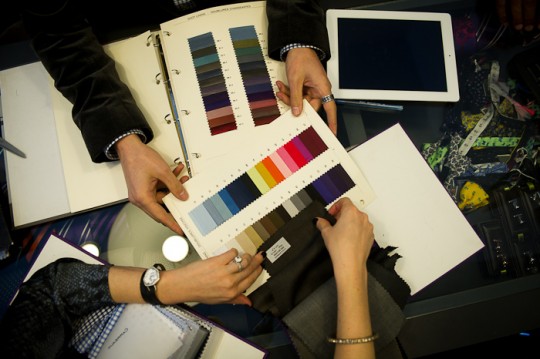 Many thanks to Lela for featuring us for groom styling on her popular NYC wedding blog. You can read the article here. We had so much fun styling our male model!Images courtesy of Christopher Duggan Photography.
Many thanks to Lela for featuring us for groom styling on her popular NYC wedding blog. You can read the article here. We had so much fun styling our male model!Images courtesy of Christopher Duggan Photography.
How to Choose a Tuxedo: Expanded Discussion for Weddings
An abbreviated version of this article appeared on the Brilliant Event Planning blog.. Dressing for a formal event is like ice climbing: one misstep, and it's all downhill. The reason there are so many rules to follow is that the point of formal dressing originally was that at formal engagements, men could blend into the crowd while their female companions could stand out in their finery. For this reason, if you're having a formal wedding, it's particularly important that you nail the details. With so many options out there, here’s your cheat sheet:Renting vs Buying: Buy if at all possible. When you have a chance to dress formally -- particularly on your wedding day -- you should look your absolute best, and renting won't achieve that. I've seen more ill-fitting rented tuxes than I care to recall. Yes, buying a good-quality, well-tailored tux is an investment, but it's a very good one that will pay dividends in photos. Not to mention you'll save in the long run not having to rent each time you need one. Renting will cost you anywhere from 25-50% of the average purchase price of a tux, so if you do it a few times, and it adds up. You'll be happy next time you get a formal invite if you're armed with a tux in your closet that fits you impeccably.
Dressing for a formal event is like ice climbing: one misstep, and it's all downhill. The reason there are so many rules to follow is that the point of formal dressing originally was that at formal engagements, men could blend into the crowd while their female companions could stand out in their finery. For this reason, if you're having a formal wedding, it's particularly important that you nail the details. With so many options out there, here’s your cheat sheet:Renting vs Buying: Buy if at all possible. When you have a chance to dress formally -- particularly on your wedding day -- you should look your absolute best, and renting won't achieve that. I've seen more ill-fitting rented tuxes than I care to recall. Yes, buying a good-quality, well-tailored tux is an investment, but it's a very good one that will pay dividends in photos. Not to mention you'll save in the long run not having to rent each time you need one. Renting will cost you anywhere from 25-50% of the average purchase price of a tux, so if you do it a few times, and it adds up. You'll be happy next time you get a formal invite if you're armed with a tux in your closet that fits you impeccably.
 .......Black Tie vs. White Tie vs. Morning Attire: The wording of your invitation dictates the color of your neckwear. "Black tie" (also referred to as "evening dress") means a black bowtie, which is traditionally worn with a tuxedo. "White tie" (also referred to as " full evening dress;" see above left) means a white bowtie, which is worn with tails. This is a very dressy look. Both black and white tie are generally worn after 6PM. A morning suit is your most formal daytime look (see above right). This is typically reserved for weddings taking place before 6PM. The morning coat (essentially a frock coat with the corners cut away -- hence the term "cutaway coat") is black or gray with a single button at the waist. Wear it with gray striped trousers, a gray or white vest, a wing collar shirt, and a tie or an ascot. Leave the top hat and walking stick at home.The information below pertains to tuxedos.Color and Fabric: Black is the standard, but midnight blue is also acceptable. White is typically worn in warmer climates for open-air events. Choose something in a wool that isn’t too heavy. Chances are you’re only going to have one tux in your closet, so it should be as versatile as possible.
.......Black Tie vs. White Tie vs. Morning Attire: The wording of your invitation dictates the color of your neckwear. "Black tie" (also referred to as "evening dress") means a black bowtie, which is traditionally worn with a tuxedo. "White tie" (also referred to as " full evening dress;" see above left) means a white bowtie, which is worn with tails. This is a very dressy look. Both black and white tie are generally worn after 6PM. A morning suit is your most formal daytime look (see above right). This is typically reserved for weddings taking place before 6PM. The morning coat (essentially a frock coat with the corners cut away -- hence the term "cutaway coat") is black or gray with a single button at the waist. Wear it with gray striped trousers, a gray or white vest, a wing collar shirt, and a tie or an ascot. Leave the top hat and walking stick at home.The information below pertains to tuxedos.Color and Fabric: Black is the standard, but midnight blue is also acceptable. White is typically worn in warmer climates for open-air events. Choose something in a wool that isn’t too heavy. Chances are you’re only going to have one tux in your closet, so it should be as versatile as possible. Jacket: The most common and versatile jacket type is a one-button, but you can also go with double-breasted (see above), which looks best on guys with broader physiques. If you wear a double-breasted jacket, a cummerbund is unnecessary. The traditional dinner jacket (a fancy name for your tux jacket) is ventless, but a you can also go for a more modern -- and generally more flattering -- look with double vents.
Jacket: The most common and versatile jacket type is a one-button, but you can also go with double-breasted (see above), which looks best on guys with broader physiques. If you wear a double-breasted jacket, a cummerbund is unnecessary. The traditional dinner jacket (a fancy name for your tux jacket) is ventless, but a you can also go for a more modern -- and generally more flattering -- look with double vents. Collar: This should be either peaked or shawl. A peaked lapel (where the points of the lapel point upward; see above and below left) reads as more powerful, whereas shawl collar (which has a continuous curve; see above and below right) sends off a softer message. Unless you’re a waiter, your wedding tux shouldn't have a notched lapel.
Collar: This should be either peaked or shawl. A peaked lapel (where the points of the lapel point upward; see above and below left) reads as more powerful, whereas shawl collar (which has a continuous curve; see above and below right) sends off a softer message. Unless you’re a waiter, your wedding tux shouldn't have a notched lapel.
 ...Cummerbund/Vest/Going Without: Formal dressing dictates that the waistband of your trousers should never show, hence the traditional need for either a vest or cummerbund. In general, the cummerbund is a more stylish option. If you wear a vest, your guests might ask where your organ and monkey are, and hopefully you won't be bringing either to your wedding, so why confuse people? Either way, the cummerbund or vest should be subtle and keep its mouth shut. Now is not the time to channel your inner Elton John. If you opt for the classic cummerbund, make sure you wear it with the pleats facing upward (fun fact: this hails from British colonial days where gentlemen used to tuck their theater tickets into the pleats). Formal dressing aside, if you want to stray from tradition, this is one place where that’s ok. These days, it’s become acceptable for guys to skip the vest or cummerbund altogether. Just make sure the shirt you buy has actual buttons or a covered placket, and this will eliminate the need for studs.Pants: Your pants never have cuffs, as that would spoil the sleek lines of your look. They should have satin banding on the sides. No belts please — your tux pants should come with side adjusters to ensure proper fit. If you still feel you need something to hold them up, you can wear suspenders in simple black or white.Shirt: Your shirt should be perfectly pressed and have French cuffs. It can have either a plain, bib or narrowly-pleated front. It’s made of marcella cotton, which is noticeably thicker than regular cotton and has a honeycomb-like appearance. The shirt is either turndown or wing collar. A turndown collar is always sharp, modern and elegant, while a wing collar is a bit of a throwback to the 19th century and works best with white tie.
...Cummerbund/Vest/Going Without: Formal dressing dictates that the waistband of your trousers should never show, hence the traditional need for either a vest or cummerbund. In general, the cummerbund is a more stylish option. If you wear a vest, your guests might ask where your organ and monkey are, and hopefully you won't be bringing either to your wedding, so why confuse people? Either way, the cummerbund or vest should be subtle and keep its mouth shut. Now is not the time to channel your inner Elton John. If you opt for the classic cummerbund, make sure you wear it with the pleats facing upward (fun fact: this hails from British colonial days where gentlemen used to tuck their theater tickets into the pleats). Formal dressing aside, if you want to stray from tradition, this is one place where that’s ok. These days, it’s become acceptable for guys to skip the vest or cummerbund altogether. Just make sure the shirt you buy has actual buttons or a covered placket, and this will eliminate the need for studs.Pants: Your pants never have cuffs, as that would spoil the sleek lines of your look. They should have satin banding on the sides. No belts please — your tux pants should come with side adjusters to ensure proper fit. If you still feel you need something to hold them up, you can wear suspenders in simple black or white.Shirt: Your shirt should be perfectly pressed and have French cuffs. It can have either a plain, bib or narrowly-pleated front. It’s made of marcella cotton, which is noticeably thicker than regular cotton and has a honeycomb-like appearance. The shirt is either turndown or wing collar. A turndown collar is always sharp, modern and elegant, while a wing collar is a bit of a throwback to the 19th century and works best with white tie. Bowtie: Always tie it yourself. If you’ve never tied one before, now is the time to learn. This guide will walk you through it. The bowtie should be black and made of silk satin or silk grosgain. If you’re more comfortable in a straight tie, it’s acceptable to wear a black one that’s relatively slim, as a more modern fashion statement (see above).Socks and Shoes: The former should be black silk hose, and the latter either black patent leather or polished black calf skin. Shoes should be lightweight and unadorned.Accessories: As mentioned above, when dressing formally, blending in is a good thing, and standing out only leads to embarrassment as it means you broke the rules somehow. If this feels overly rigid, and you’re itching to show some personal style, you can do so via your accessories. Just make sure you keep the look subtle and nuanced. Your pocket square, cuff links, studs, watch (which matches your cuff links) and charming personality are excellent ways to do so.Fit: As with suiting, fit is your everything when it comes to formal attire. It should fit close to your frame with the jacket hitting exactly on your shoulders. The break on your pants can be slightly shorter than what you normally get on regular trousers.While there is quite a bit to keep in mind with black-tie dressing, don’t let it intimidate you. After all, wearing a tux is about confidence and panache. Once you figure it out, you’ll find that a tux can be completely transformative for any man. It’s absolutely worth the work.
Bowtie: Always tie it yourself. If you’ve never tied one before, now is the time to learn. This guide will walk you through it. The bowtie should be black and made of silk satin or silk grosgain. If you’re more comfortable in a straight tie, it’s acceptable to wear a black one that’s relatively slim, as a more modern fashion statement (see above).Socks and Shoes: The former should be black silk hose, and the latter either black patent leather or polished black calf skin. Shoes should be lightweight and unadorned.Accessories: As mentioned above, when dressing formally, blending in is a good thing, and standing out only leads to embarrassment as it means you broke the rules somehow. If this feels overly rigid, and you’re itching to show some personal style, you can do so via your accessories. Just make sure you keep the look subtle and nuanced. Your pocket square, cuff links, studs, watch (which matches your cuff links) and charming personality are excellent ways to do so.Fit: As with suiting, fit is your everything when it comes to formal attire. It should fit close to your frame with the jacket hitting exactly on your shoulders. The break on your pants can be slightly shorter than what you normally get on regular trousers.While there is quite a bit to keep in mind with black-tie dressing, don’t let it intimidate you. After all, wearing a tux is about confidence and panache. Once you figure it out, you’ll find that a tux can be completely transformative for any man. It’s absolutely worth the work.
Wedding Attire: Non-Tux Alternatives for Grooms
As seen on the Brilliant Event Planning blog. Every groom should look dashing at his wedding. If the dress code permits, ditch the tux in favor of a well-chosen, perfectly-fitting suit. The beauty of buying a knock-out suit is that once you have it, you can wear it for different occasions like job interviews or other important events. It’s a wise use of your wedding budget, and all guys look fantastic in a well-fitted suit.Here are some of my top tips on suiting up your wedding:
Every groom should look dashing at his wedding. If the dress code permits, ditch the tux in favor of a well-chosen, perfectly-fitting suit. The beauty of buying a knock-out suit is that once you have it, you can wear it for different occasions like job interviews or other important events. It’s a wise use of your wedding budget, and all guys look fantastic in a well-fitted suit.Here are some of my top tips on suiting up your wedding:
- Color: A navy or grey suit with a white shirt and black shoes are excellent options. If you’re not asking your groomsmen to buy the same exact suit as yours (which is a great way to build goodwill with them, especially if budget is an issue), you should give them guidance on color. In this situation, opt for navy because if you just tell them, “buy grey suits,” you’ll end up with all different shades and patterns. Black can work too, but it’s a strong color that not everyone looks good in, so go with the easier-to-wear navy.
- Time of Day: If your wedding is a more casual, daytime affair, you can wear a navy blazer, shirt, and tie with khaki, grey or seersucker pants. To look really pulled together with this option, match the metals of your belt buckle and watch to the buttons on your blazer. So if your buttons are gold, wear a gold buckle and a gold watch. With silver-tone buttons, opt for silver accessories.
- Ties: Neckwear provides a nice way to coordinate with the color the bridesmaids are wearing and with the color scheme of the overall event. Look for ties that pick up on colors that will appear elsewhere in the wedding. If you’re wearing a suit and you’d rather stick to a more classic and simple style for yourself, try a long white or silver tie, and let your groomsmen do the color thing. That way, you’ll have a look that pulls the event together as a cohesive whole.

